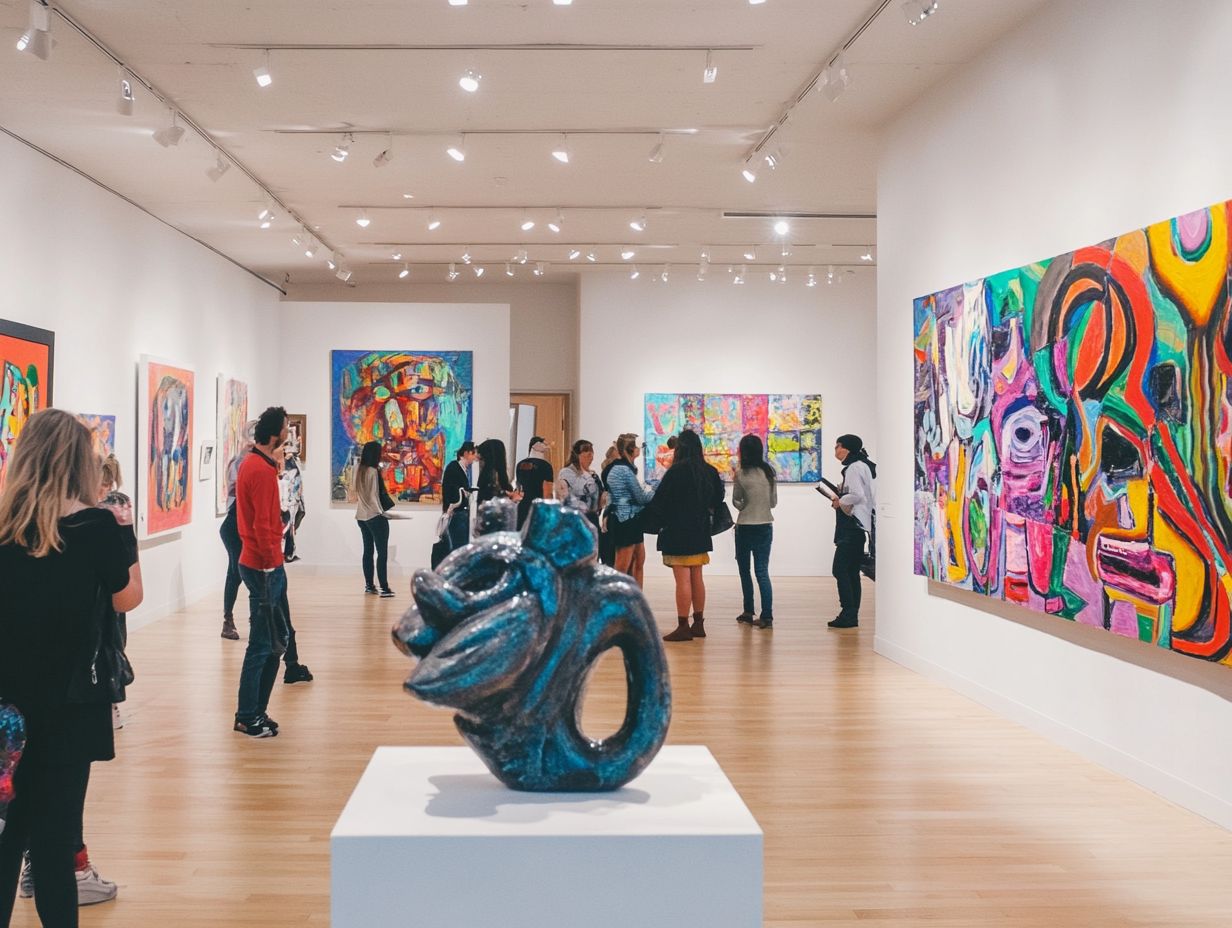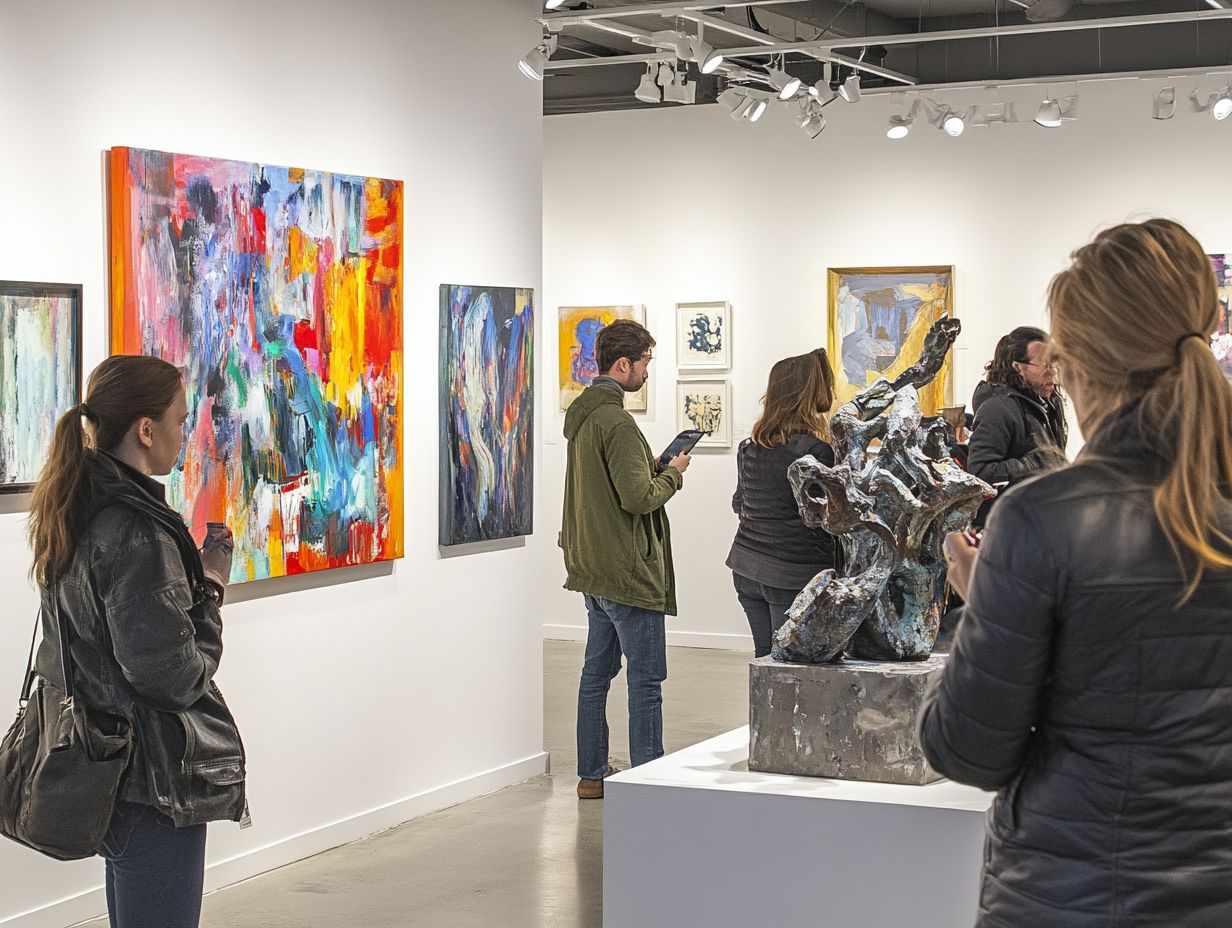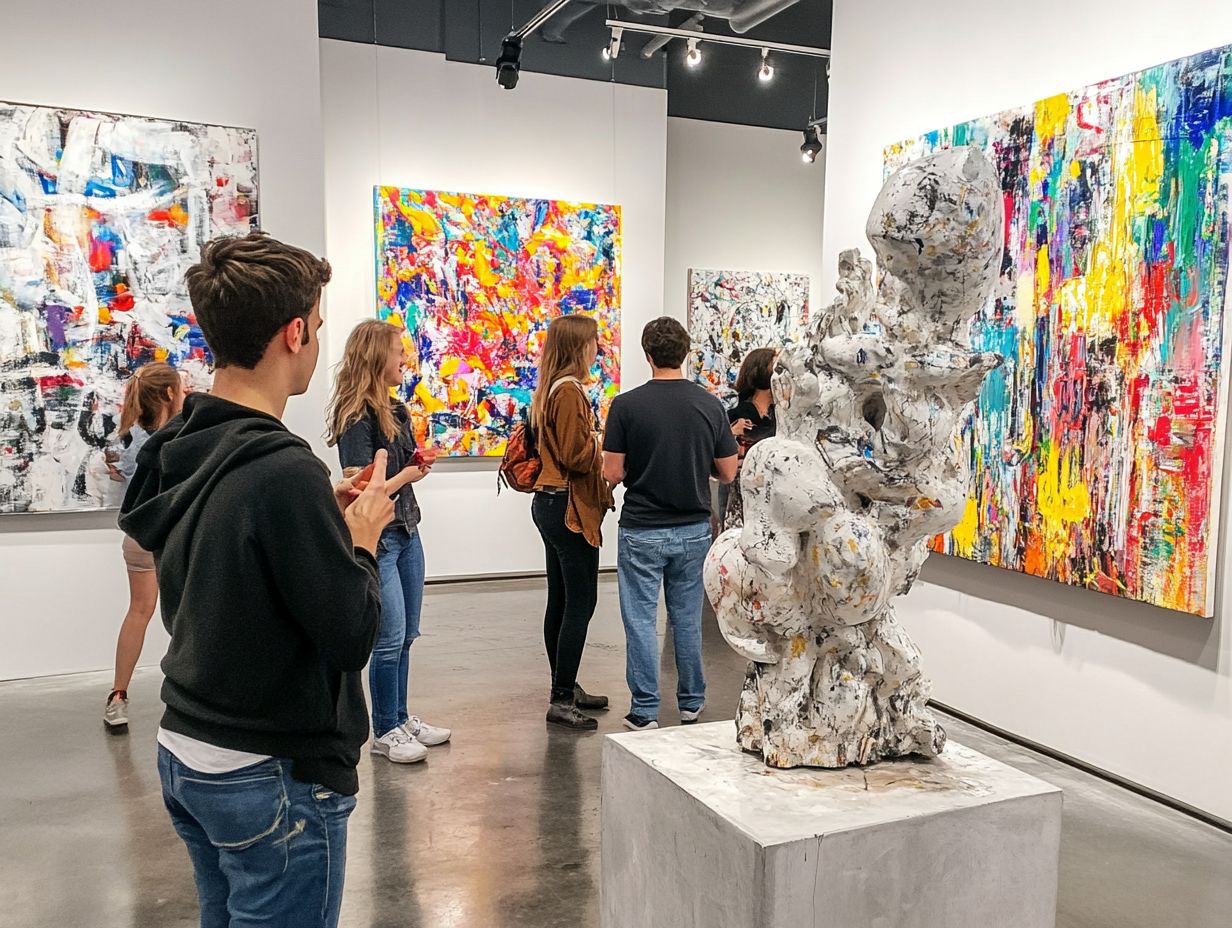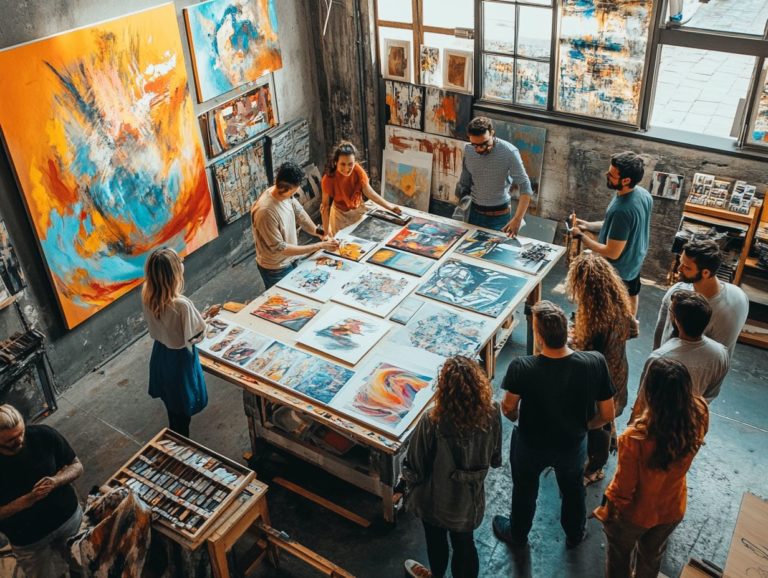The Role of Art in Alternative Investment Strategies
Art is emerging as a compelling alternative investment, capturing the attention of a diverse array of investors keen on diversifying their portfolios. Join the growing number of investors integrating art into their strategies!
The rising interest in art as an investment vehicle is substantiated by current trends and statistics that highlight its appeal. You ll discover the benefits it offers, including diversification and potential returns, while also considering the risks associated with market volatility and liquidity challenges. Liquidity refers to how easily you can buy or sell an asset. Expert insights and practical strategies will guide you in effectively incorporating art into your investment portfolio.
Embark on this journey as you navigate through this fascinating market.
Contents
- Key Takeaways:
- Defining Alternative Investments
- The Growing Popularity of Art as an Alternative Investment
- Benefits of Investing in Art
- Diversification and Potential Returns
- Risks and Challenges of Art Investment
- Market Volatility and Liquidity
- Factors to Consider Before Investing in Art
- Expert Opinions and Due Diligence
- How to Incorporate Art into Your Investment Portfolio
- Frequently Asked Questions
- What is the role of art in alternative investment strategies?
- How is art considered an alternative investment?
- What are some types of art that can be used in alternative investment strategies?
- What are the potential risks of using art in alternative investment strategies?
- Are there any tax benefits to using art in alternative investment strategies?
- What should investors consider before incorporating art into their alternative investment strategies?
Key Takeaways:

Investing in art can provide diversification and potential returns as part of an alternative investment strategy. However, market volatility and liquidity are risks to consider when incorporating art into an investment portfolio. It is important to conduct due diligence and seek expert opinions before making any art investment decisions.
Defining Alternative Investments
Alternative investments encompass asset classes that stand apart from the traditional realm of stocks, bonds, and cash. This category includes tangible assets like real estate, commodities, and, perhaps most intriguingly, art.
High-net-worth individuals are showing significant interest in the art market, eager to diversify their investment portfolios while protecting themselves against market fluctuations. As the financial world continues to evolve, alternative investments are emerging as a compelling option for refining wealth management strategies, particularly through art funds and other specialized vehicles that present unique opportunities for growth.
The Growing Popularity of Art as an Alternative Investment
The rising allure of art as an alternative investment is transforming investment portfolios, particularly for high-net-worth individuals in search of distinct asset classes. To navigate this space effectively, it’s crucial to understand the risks of art investments.
In recent years, contemporary art has asserted itself as a formidable presence in the art market, captivating both collectors and investors. During economic downturns, art retains its cultural significance and acts as a hedge against inflation, positioning it as an enticing option for diversification within your portfolio.
Trends and Statistics
Current trends and statistics reveal a promising growth trajectory for the art market, with prestigious auction houses like Sotheby’s and Christie’s reporting record-breaking sales.
You might notice a surge in demand for contemporary artists, largely driven by a new generation of collectors eager for high returns and unique art assets. This dynamic interplay of market demand and art valuation emphasizes the financial potential of art investments.
Consider this: Sotheby’s recorded an astonishing $3.7 billion in global auction sales in 2022, with contemporary art accounting for nearly half of that figure. Case studies highlight how artists like Banksy have witnessed their works appreciate by over 300% in just a few years, illustrating how investor interest can dramatically influence art values.
As market demand fluctuates, investors are increasingly focused on both established names and emerging talents, searching for pieces that resonate aesthetically and promise future value appreciation. This trend points to a notable shift in investment strategies, where art is becoming an essential component of diversified portfolios.
Benefits of Investing in Art

Investing in art presents many benefits, especially through diversification strategies that can significantly enhance your investment portfolio and secure impressive returns.
For high-net-worth individuals, contemporary art has emerged as an essential asset, marrying financial potential with cultural appreciation.
Engaging in art investment strategies opens up distinctive avenues for art collectors, giving them the power to leverage their assets within the sphere of wealth management. Additionally, understanding the role of insurance in alternative investments allows investors to skillfully navigate market volatility.
Investing in art isn t just a smart move; it s an exhilarating journey into a world of creativity and financial growth!
Diversification and Potential Returns
Diversifying your investment portfolio is essential for minimizing risks. Art offers a distinctive pathway to achieve this while potentially maximizing returns.
Art funds have become increasingly attractive for investors like you. They allow you to engage with the art market without the complexities of direct ownership. However, these funds can also present liquidity challenges that require careful appraisal.
As you explore various artists and genres, you’ll discover that the potential for profit can vary significantly. For instance, contemporary works by artists such as Jeff Koons can fetch millions at auctions. This showcases their capacity for dramatic appreciation over time.
Conversely, traditional pieces from the Renaissance tend to exhibit more stability. They may offer less volatility in pricing, which can be beneficial for risk-averse investors.
Successful art funds, like the Artcurial and Mei Moses indices, illustrate how balanced portfolios empower you. They allow you to capitalize on the unique attributes of art while remaining mindful of inherent risks.
The key lies in striking a harmonious balance between risk and reward. Ensure that your art investments align seamlessly with your broader financial objectives.
Risks and Challenges of Art Investment
The art market presents a wealth of opportunities for discerning investors. Yet, it also harbors notable risks and challenges.
Market volatility and liquidity issues can significantly influence art valuation. A keen understanding of the landscape is essential as you navigate this intricate space.
It’s vital to remain vigilant about potential financial pitfalls, especially during economic downturns. The unpredictable behavior of auction houses can greatly affect your overall investment performance, making careful consideration paramount.
Market Volatility and Liquidity
Market volatility can significantly influence your art investments. This may lead to liquidity challenges that impede art transactions and complicate your overall investment management.
Understanding how these factors contribute to the cyclical nature of the art market is crucial. This knowledge will allow you to prepare effectively and maximize your financial potential.
Economic unpredictability creates a fluctuating demand for art, resulting in significant price adjustments. During economic downturns, collectors may choose to hold onto their assets, causing art sales to decline.
This can extend the time it takes to sell pieces, making it harder to convert artworks into cash. These liquidity challenges can be particularly daunting if you’re looking to divest quickly.
The performance of the art market is frequently intertwined with broader economic indicators. When stock markets wobble, investors may diversify into art, enhancing its perceived value.
To navigate these uncertainties, consider adopting a strategic approach. Focus on established artists, build relationships with reputable galleries, and diversify your portfolio to mitigate the risks associated with market fluctuations.
Factors to Consider Before Investing in Art

Before you invest in art, it s essential to dive deep into your research. Conduct meticulous due diligence and consult with experts to ensure your decisions are well-informed.
Consider factors like art appraisal, grasping market trends, and engaging with industry specialists. These elements can profoundly shape your investment strategies, particularly for high-net-worth individuals maneuvering through this intricate market.
Expert Opinions and Due Diligence
Engaging experts and performing thorough due diligence are crucial for successful art investments. Art valuation often carries a subjective nature and is swayed by market trends.
Consulting with art industry experts provides invaluable insights into the current landscape. This ensures compliance with IRS regulations regarding art investment transactions.
These experts guide you through the intricate world of art, ensuring that each piece is evaluated comprehensively. This evaluation considers not just aesthetic appeal but also potential appreciation and resale value.
By critically assessing factors such as provenance, market demand, and condition, you can refine your investment strategies effectively.
Understanding IRS guidelines is equally vital, as they dictate how art is classified and valued for tax purposes. This influences everything from deductions to capital gains.
Aligning your investment decisions with these regulations not only protects you from potential legal pitfalls but also enhances your overall investment strategy.
How to Incorporate Art into Your Investment Portfolio
Incorporating art into your investment portfolio requires careful planning and custom strategies that enhance your portfolio’s diversification.
As an art collector or wealthy individual, you can boost your success in the art market by leveraging options like hedge funds and art funds.
These avenues play a pivotal role in aligning your investments with your long-term financial goals.
Strategies and Tips
Implementing effective art investment strategies can yield significant returns. Leverage insights from art auctions and be aware of market trends.
As an art collector, understanding liquidity issues how easily you can sell your art when needed is essential for investment success.
To navigate art auctions like a pro, familiarize yourself with various auction houses. Research their reputations and the types of artworks they typically feature.
Attending previews is highly advisable. It allows you to gauge interest levels and assess artworks in person, which is invaluable for informing your bidding strategies.
Cultivating a discerning eye is also crucial. Look for emerging artists with promising potential and established names whose markets might be undervalued.
A diversified portfolio that spans various mediums and styles helps manage risks while enhancing returns.
Regularly check market conditions. Staying updated will help you manage how easily you can sell your art, enabling timely sales that capitalize on favorable market fluctuations.
Frequently Asked Questions
What is the role of art in alternative investment strategies?
The role of art in alternative investment strategies is to diversify portfolios and potentially generate higher returns compared to traditional investment options, making understanding art valuation for investors crucial.
How is art considered an alternative investment?
Art is an alternative investment because it is not a traditional asset class like stocks, bonds, or real estate. It is also not subject to the same market forces, having a unique value based on subjective factors like cultural significance and aesthetic appeal.
What are some types of art that can be used in alternative investment strategies?
Types of art that can be used in alternative investment strategies include paintings, sculptures, photography, and collectible items like rare coins and stamps.
What are the potential risks of using art in alternative investment strategies?
A potential risk of using art in alternative investment strategies is the lack of liquidity. Unlike traditional investments, selling art quickly and easily may be difficult. Additionally, art values can fluctuate based on trends and market demand.
Are there any tax benefits to using art in alternative investment strategies?
Yes, there may be tax benefits. In some cases, investors can defer taxes on capital gains from art sales if they reinvest the proceeds into another piece of art.
What should investors consider before incorporating art into their alternative investment strategies?
Investors should weigh the potential risks, costs, and their overall investment goals. Consulting with a financial advisor or art investment expert can ensure alignment with their portfolio objectives.
In conclusion, incorporating art into your investment portfolio can enhance diversification and offer unique opportunities. Explore art investment options to align with your financial goals!







